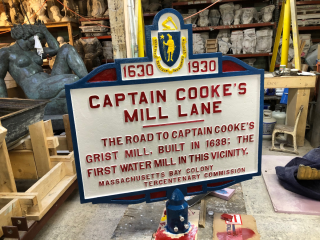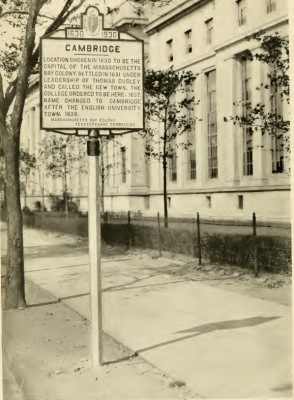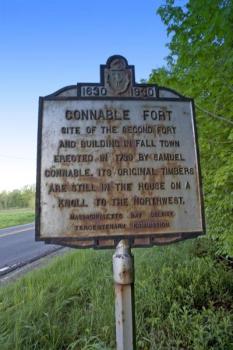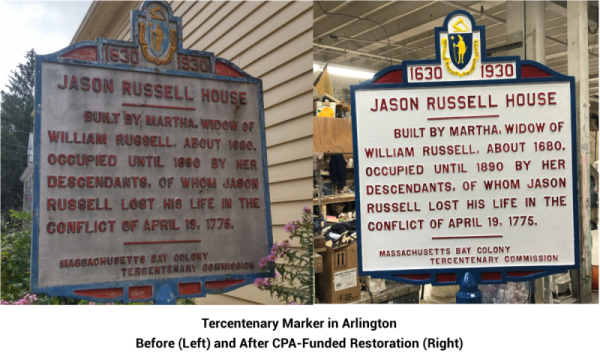The Tercentenary Markers - Restoring 300 Years of Massachusetts State History with CPA

Written by Chase Mack
“The travelers who shall pass by the many storied ways through the lands of the Puritan occupations in the ancient days of the Massachusetts Bay Colony, may now read on tablets set by roadsides or in city streets the tales which the ocean shores, the hills, the fields, the churches, the garrison houses, and the old hearthstones, have to tell of the heroism, of the romance and of the tragedies, and of the unfaltering faith, of the ancestors of our Commonwealth.” – Herbert Parker, Chairman of the Massachusetts Bay Colony Tercentenary Commission (1930)
 Across the state of Massachusetts, in dozens of different communities, one can find the Tercentenary Markers - these humble signposts were created and installed nearly a century ago, but they perfectly encapsulate the importance of historic preservation in our Commonwealth. The posts and tablets are made of cast iron, with identical text on both sides so that passers-by from either direction would be able to read the inscriptions. Each of these markers highlights a piece of Massachusetts state history: detailing the establishment of individual municipalities, marking the historic homesteads of prominent figures, and identifying the original sites of indigenous villages and landmarks.
Across the state of Massachusetts, in dozens of different communities, one can find the Tercentenary Markers - these humble signposts were created and installed nearly a century ago, but they perfectly encapsulate the importance of historic preservation in our Commonwealth. The posts and tablets are made of cast iron, with identical text on both sides so that passers-by from either direction would be able to read the inscriptions. Each of these markers highlights a piece of Massachusetts state history: detailing the establishment of individual municipalities, marking the historic homesteads of prominent figures, and identifying the original sites of indigenous villages and landmarks.
However, just as the Massachusetts Bay Colony Tercentenary Commission realized the importance of recognizing history before it is forgotten, present-day citizens are now acknowledging the fact that the signs are historically significant in of themselves - and in dire need of restoration after a hundred years have passed since their installation. And as the town of Arlington has discovered, the Community Preservation Act is the perfect tool to ensure that the Tercentenary Markers continue to tell these important stories for another hundred years to come.
In 1930, the state’s Department of Public Works was authorized to create and install 275 Tercentenary Markers under the guidance of the Massachusetts Bay Colony Tercentenary Commission in recognition of the 300th anniversary of the original colony’s founding. The Legislature approved of $100,000 to commission the creation of the signs (this would be the equivalent of nearly $1.8 million today), and the Commission then set out to erect the iron markers across 96 municipalities during that same year. Each tablet spans thirty-six inches in width, with the length varying according to the amount of text inscribed. Originally painted with aluminum with a prominent gold and blue state insignia at the top, these markers would have stood out to any travelers as unique - many historic markers or memorial tablets at the time were typically cast as flat, bronze plates, usually installed on a boulder or other nearby surface, often with small, inconspicuous lettering. Conversely, the intention for the Tercentenary Markers was to capture the attention of Massachusetts citizens, even if they were traveling by car.
 Each Tercentenary Marker tells a concise, significant story about the history of Massachusetts - with just a few short lines inscribed across hundreds of markers, the Commission sought to instill a sense of wonder and historic weight for a new generation set to inherit 300 years’ worth of toil, tragedy, and progress. Today, however, it’s unclear how many of the original Tercentenary Markers still exist. On the Historical Marker Database website, users have cataloged 163 of the markers with known locations. Unfortunately, many of the original markers have been lost to time, or have fallen into a state of disrepair. But because of the historic significance of the markers themselves, communities that have adopted CPA have the perfect opportunity to restore these local artifacts to their former glory (and why wait until the state’s Quatercentenary to do so?)
Each Tercentenary Marker tells a concise, significant story about the history of Massachusetts - with just a few short lines inscribed across hundreds of markers, the Commission sought to instill a sense of wonder and historic weight for a new generation set to inherit 300 years’ worth of toil, tragedy, and progress. Today, however, it’s unclear how many of the original Tercentenary Markers still exist. On the Historical Marker Database website, users have cataloged 163 of the markers with known locations. Unfortunately, many of the original markers have been lost to time, or have fallen into a state of disrepair. But because of the historic significance of the markers themselves, communities that have adopted CPA have the perfect opportunity to restore these local artifacts to their former glory (and why wait until the state’s Quatercentenary to do so?)
In 2019, the town of Arlington approved the use of CPA historic preservation funding in order to preserve two of their Tercentenary Markers at the Jason Russell House and Captain Cooke’s Mill Lane. Both signs had suffered major corrosion and paint loss on the markers and the original iron posts, but advocates from the Arlington Historical Society, caretakers from these historic properties, and the town’s Historical Commission supported their full restoration through their local CPA program. The town worked with the Department of Public Works in order to temporarily remove the signs, restore the painting work, and re-install them in their original locations.
 According to the treatment report provided to the Arlington Community Preservation Committee, while the signs were still structurally sound, the surface of both markers were in poor condition, with corrosion and rust prevalent across the surface and much of the existing paint eroded or bleached in color. The restoration work included stripping the remaining paint, pressure washing and sand-blasting the surfaces of each marker, and then applying multiple coats of new primer and oil-based paint by brush. The end-results speak for themselves: while commercial color photography was still in its infancy when the signs were first installed, it’s easy to imagine that the newly-restored Tercentenary Markers in Arlington now appear much as they did when first created nearly one hundred years ago.
According to the treatment report provided to the Arlington Community Preservation Committee, while the signs were still structurally sound, the surface of both markers were in poor condition, with corrosion and rust prevalent across the surface and much of the existing paint eroded or bleached in color. The restoration work included stripping the remaining paint, pressure washing and sand-blasting the surfaces of each marker, and then applying multiple coats of new primer and oil-based paint by brush. The end-results speak for themselves: while commercial color photography was still in its infancy when the signs were first installed, it’s easy to imagine that the newly-restored Tercentenary Markers in Arlington now appear much as they did when first created nearly one hundred years ago.
Carrying our state’s historic legacy forward for future generations was the clear goal of the men and women that installed the original Tercentenary Markers across Massachusetts, and the Community Preservation Act demonstrates that this ideal is still paramount for present-day citizens of our Commonwealth. Because these historic emblems were installed across so many communities, it’s very likely that your municipality’s CPA program could be utilized to preserve your own local markers from further decay. After the 275 original markers had been installed, the final act of the Massachusetts Bay Colony Tercentenary Commission was to publish a catalog of their work, including the full text of every Tercentenary Marker and several photographs of the original erected signs. And nothing underscores the historic significance of these markers better than the epigraph from that catalog:
“No labor of historian, no eloquence of orator, will stir the heart of youth to the love of country, and a desire to emulate the great deeds of the past, like a visit to the spot which has been familiar with the presence of great men, or the scene where great deeds have been enacted.” – George Frisbie Hoar
Editor’s Note: While this CPA Success Story profiles one community's historic preservation work on non-controversial Tercentenary Markers, it is important to acknowledge that many of these signs provide a problematic depiction of historic events, especially in regards to indigenous peoples. According to an article in the Historical Journal of Massachusetts in 2022, nearly one-third of the Tercentenary Markers reference the presence or actions of the colony’s Native American inhabitants, many of which present a distorted perspective that villainizes the native “Indians” of the time.
If your community is considering restoration efforts for any local Tercentenary Markers, it is vital to recognize these historical biases. The Coalition urges communities to make careful deliberation as to whether preservation efforts and public display of specific Tercentenary signs would perpetuate harmful, misleading, or prejudiced perspectives of historic events.
Further Resources:
- History of the Tercentenary Commission Markers by Russel C. Bixby
- "Marked Territory: Rethinking Massachusetts' Roadside Histories" - Article by Emma Boast in Summer 2022 edition of Historical Journal of Massachusetts
- Database of All Known Tercenatary Markers
- Historical Markers Erected by Massachusetts Bay Colony Tercentenary Commission – Published in 1930, available in digital format at the Internet Archive
- Arlington Tercentenary Marker Restoration Treatment Report

